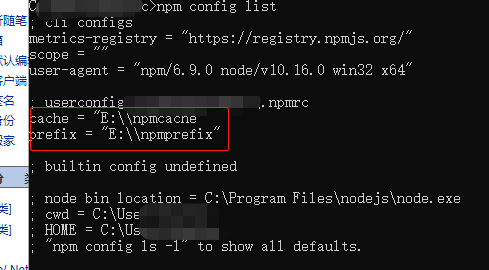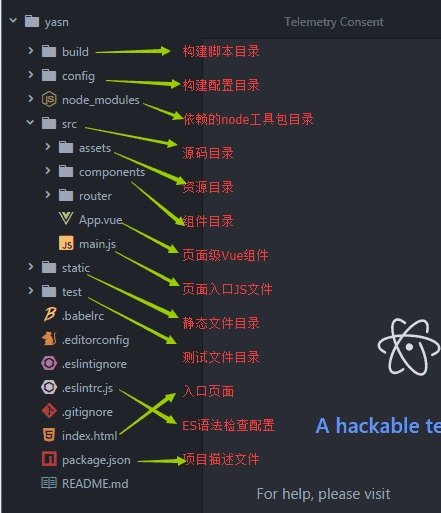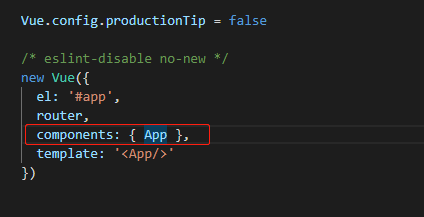安装vue.js。
1、安装node.js,有自带的npm管理工具
2、由于官网的链接在国外下载比较慢,可使用淘宝镜像(https://npm.taobao.org/)。
$ npm install -g cnpm --registry=https://registry.npm.taobao.org
3、设置npm的全局模块存放的地址和缓存存放地址
npm config set prefix "c:\Program Files\nodejs\node_global"
npm config set cache "c:\Program Files\nodejs\node_global"
4、安装vue-cli:脚手架
全局安装->npm install -g vue-cli
切换到需要创建的目录下执行:vue init webpack projectName
(如vue命令提示不存在命令,可用以下命令查看prefix地址,找到vue.cmd目录,讲目录存放在系统环境变量中,如何设置环境变量就不细说)

前端UI:ELEMENT npm install element-ui --save-dev
5、vue-cli目录

6、初始化安装依赖并运行
npm install
npm run dev 生成环境使用 npm run build命令
7、vue指令
<!-- v-text -->
{{ vText }}
<!-- v-if/v-else-if/v-else -->
<div v-if="vIf>5">v-if</div>
<div v-else-if="vIf >2">v-else-if</div>
<div v-else>v-else</div>
<hr/>
<!--
v-html 将值中带html元素进行渲染
v-text 当普通值输出
-->
<p>Using mustaches: {{ vHtml }}</p>
<p>Using v-html directive: <span v-html="vHtml"></span></p>
<hr/>
<!--
v-show 更改的css display样式
v-if 只用条件满足时渲染
-->
<h1 v-show="1!=1">Hello!</h1>
<!-- v-for
只支持:Array|Object|number | String |Iterable
v-for 不能与v-if一起使用
<div v-for="(item, index) in items"></div>
<div v-for="(val, key) in object"></div>
<div v-for="(val, name, index) in object"></div>
:key 特性为项提供唯一标识
-->
<ol>
<li v-for="t in vFor" v-show="vIf==1" :key="t.id">
{{ t.text }}
</li>
<li v-show="vIf==2" v-for="(value,name) in object" :key="value">
{{ name }}-{{ value.id}}-{{ value }}-
</li>
<li v-show="vIf==3" v-for="(value,key) in vFor" :key="value.key">
{{ key }}-{{ value.id}}-{{ value }}-
</li>
<li v-show="vIf==4" v-for="(val, name, index) in object">
{{ index }}-{{ name}}-{{ val }}-
</li>
</ol>
* v-model
<!-- v-model
主要用于表单控件<input><textarea><select>
-->
<input v-model="vHtml" placeholder="edit me">
<p>Message is: {{ vHtml }}</p>
<!-- 单选框 -->
<!-- <input type="checkbox" id="checkbox" v-model="vIf">
<label for="checkbox">{{ vIf }}</label> -->
<!-- 复选框 -->
<input type="checkbox" id="jack" value="Jack" v-model="checkedNames">
<label for="jack">Jack</label>
<input type="checkbox" id="john" value="John" v-model="checkedNames">
<label for="john">John</label>
<input type="checkbox" id="mike" value="Mike" v-model="checkedNames">
<label for="mike">Mike</label><br/>
<span>Checked names: {{ checkedNames }}</span>
<select v-model="checkedNames" multiple>
<option v-for="option in vFor" v-bind:value="option.id">
{{ option.text }}
</option>
</select>
<span>Selected: {{ checkedNames }}</span>
* v-on
<!-- v-on 监听HTML事件
可以简写为@名称
事件修饰符:
.stop 阻止单击事件继续传播
.prevent 提交事件不再重载页面
.capture
.self
.once
.passive
-->
<div>
<button @click="doThis">v-on</button>
<!-- 内联语句 -->
<button @click="doThis('111')">v-on</button>
<!-- 停止冒泡 -->
<button @click.stop="doThis">v-on</button>
<!-- 阻止默认行为 -->
<button @click.prevent="doThis">v-on</button>
<!-- 阻止默认行为,没有表达式 -->
<form @submit.prevent>v-on</form>
<!-- 串联修饰符 -->
<button @click.stop.prevent="doThis">v-on</button>
<!-- 键修饰符,键别名 -->
<input @keyup.enter="doThis">
<!-- 键修饰符,键代码 -->
<input @keyup.13="doThis">
<!-- 点击回调只会触发一次 -->
<button v-on:click.once="doThis">v-on</button>
<!-- 对象语法 (2.4.0+) -->
<button v-on="{ mousedown: doThis, click: doThat }">v-on</button>
<!-- 提交事件不再重载页面 -->
<form v-on:submit.prevent="doThis">submit.prevent</form>
<!-- 修饰符可以串联 -->
<a v-on:click.stop.prevent="doThat">click.stop.preven</a>
<!-- 添加事件监听器时使用事件捕获模式 -->
<!-- 即元素自身触发的事件先在此处理,然后才交由内部元素进行处理 -->
<div v-on:click.capture="doThis">click.captur</div>
<!-- 只当在 event.target 是当前元素自身时触发处理函数 -->
<!-- 即事件不是从内部元素触发的 -->
<div v-on:click.self="doThat">click.self</div>
<!-- 滚动事件的默认行为 (即滚动行为) 将会立即触发 -->
<div v-on:scroll="onScroll" style="height:50px;overflow-y: scroll;">
scroll.passive<br/>
scroll.passive<br/>scroll.passive<br/>scroll.passive<br/>scroll.passive<br/>scroll.passive<br/>
</div>
<input v-on:keyup.page-down="doThat">
</div>
*
8、vue生命周期中的钩子函数
beforeCreate(){//在实例初始化之后
console.log('beforeCreate');
},
created(){//在实例创建完成后被立即调用
console.log('created');
},
beforeMount(){//在挂载开始之前被调用
console.log('beforeMount');
},
mounted(){//el 被新创建的 vm.$el 替换,并挂载到实例上去之后调用该钩子
console.log('mounted');
this.doThis();
},
beforeUpdate(){//数据更新时调用,发生在虚拟 DOM 打补丁之前
console.log('beforeUpdate');
},
updated(){//由于数据更改导致的虚拟 DOM 重新渲染和打补丁,在这之后会调用该钩子。
console.log('updated');
},
beforeDestroy(){//实例销毁之前调用。在这一步,实例仍然完全可用
console.log('beforeDestroy');
},
destroyed(){//Vue 实例销毁后调用
console.log('destroyed');
},
errorCaptured(){//当捕获一个来自子孙组件的错误时被调用
console.log('errorCaptured');
}
9、组件的使用
1)全局调用,
Vue.component('my-component-name', { // ... 选项 ... })
在vue-cli项目中main.js

2)局部调用
import ButtonCounter from '../components/ButtonCounter'
export default {
name: 'HelloWorld',
data () {}
components:{
ButtonCounter
}
}
3)父级传值给子级组件
* 在自己vue props: ['title',...],可以自定参数的属性
props: {
// 基础的类型检查 (`null` 和 `undefined` 会通过任何类型验证)
propA: Number,
// 多个可能的类型
propB: [String, Number],
// 必填的字符串
propC: {
type: String,
required: true
},
// 带有默认值的数字
propD: {
type: Number,
default: 100
},
// 带有默认值的对象
propE: {
type: Object,
// 对象或数组默认值必须从一个工厂函数获取
default: function () {
return { message: 'hello' }
}
},
// 自定义验证函数
propF: {
validator: function (value) {
// 这个值必须匹配下列字符串中的一个
return ['success', 'warning', 'danger'].indexOf(value) !== -1
}
}
}
* 父级插入子级组件:<ButtonCounter :title ="'111111'"></ButtonCounter>
4)子级传值给父级
* 在自己的事件中定义 this.$emit('enlarge-text', 0.1)
* 父级使用
<template>
<button-counter @enlarge-text="onEnlargeText" :title ="'333'"></button-counter>
</template>
import ButtonCounter from '../components/ButtonCounter'
export default {
name: 'HelloWorld',
data () {}
components:{
ButtonCounter
}
}
10、插槽的使用
11、js模拟双向绑定数据
<div id="app">
{{ message }}
<span v-bind:title="message">
鼠标停留
</span>
<!-- v-if -->
<p v-if="seen">现在你看到我了</p>
<input type="text" id="txt">
<p id="show"></p>
<!-- v-for -->
</div>
<script>
var obj = {}
Object.defineProperty(obj, 'txt', {
get: function () {
return obj
},
set: function (newValue) {
document.getElementById('txt').value = newValue
document.getElementById('show').innerHTML = newValue
}
})
document.addEventListener('keydown', function (e) {
obj.txt = e.target.value
});
document.addEventListener('keyup', function (e) {
obj.txt = e.target.value
})
</script>
12、



